Contents
Market Overview
Macro Review
Why is the Bank of England’s monetary policy relevant? Governor Bailey has arguably been the most honest G10 Central Banker in the latest MPC yet. The debate around monetary tightening was not the key focal point. Expectations were largely set on 50bp, which made for an unpleasant headline in that it is the largest rate rise since 1995. However, the focus was more on inflation rising from 9.4% to 13% and remaining at that elevated level through to the end of 2023, with five quarters of negative GDP growth beginning from 4Q this year. The Bank of England are also expected to hike another 50bp in September, before a final 25bp in November as the recession gloom sets in. The central bank did leave some optionality around quantitative tightening, insofar as delaying sales until after the September meeting, rather than bringing the process forward (similar to the ECB but in contrast to the Fed). The UK Gilt curve via 2s10s briefly inverted for the first time since 2019, before the 2-year note rallied 20bp on recession fears. Meanwhile, the U.S. seems in better shape. A sizzling jobs market with 528k new jobs in July moved unemployment to a 50-year low (3.5%), but naturally increases the odds of another 75bp hike in September. This leaves EM in an odd place. Brazil’s tightening cycle is seemingly coming to an end after the recent 50bp hike, which came with a dovish tweak in the statement and means the central bank could soon pause policy. Brazil’s pivot is fair after a front-loaded tightening cycle that began in 2021, but less can be said for the Czech Republic which surprisingly held rates unchanged when inflation is already above 17% (Poland’s inflation isn’t far behind). The trend is more polarized with red-hot CEEMEA and Asian inflation relative to a moderating path in LATAM. A second example is Peru, with inflation that eased from 8.8% to 8.7%. The chants of “peak inflation” were steadied by the trend in G10 countries though. Then, fatiguing U.S. growth is weighing on commodity markets once again, just as the U.S. Treasury curve on a 2s10s basis has inverted to beyond -40bp. Crude oil is down some 14% this week at $95/bbl, with WTI trading below $90/bbl. The production increase of 100k bpd by OPEC+ was merely a rounding error, while the recessionary fears are dominating the agenda. The next question is whether a U.S. nuclear agreement with Iran in Vienna can cause further weakness. Implications around Nancy Pelosi’s visit to Taiwan and China’s reaction thus far have had limited market impact.
EM Credit Update
Emerging market sovereign credit ended the week up 1.1% with spreads 16bp tighter. Outperformers over the week were Sri Lanka, Zambia and Pakistan while Ukraine, El Salvador and Argentina underperformed. Key news items over the week include Sergio Massa’s economic reform agenda in Argentina. Brewing tensions in Kosovo saw Serbian spreads widen 50-90bp too. Ukraine also introduced a “Most Favored Creditor Clause” into the consent solicitation to force bondholders to sign up to the proposal and cram out dissenters. The pressure is also mounting on Ukraine as it has not paid the coupon on the 8.994% 2024 Eurobond, which has a grace period of ten-days. On a technicality, an event of default could trigger Ukraine’s CDS deliverable auction prior to the consent solicitation passing, but this is still very unlikely.
The Week Ahead
Key events next week include U.S. CPI. However, we will also see inflation releases out of China and Germany. Earnings season across developed markets is also beginning to draw to a close, with 423 of the S&P 500 constituents already having reported. Interest rate decisions are due out of Mexico (7.75%) and Thailand (0.5%), with central bank minutes from Brazil’s COPOM. Aside from the inflation releases above, the more minor updates are due from Argentina, Brazil, Chile, Czech Republic, Hungary, India and Poland. Turkey’s current account release is also due next week, which should narrow from a deficit print of -$6bn in May. Finally, elections in Kenya on Tuesday are set to be exceptionally close and risk adding further volatility to the sovereign bond curve.
Highlights from emerging markets discussed below include: China’s response to Pelosi’s Taiwan visit, new stabilization efforts in Argentina and economic and political news from Brazil.
Fixed Income
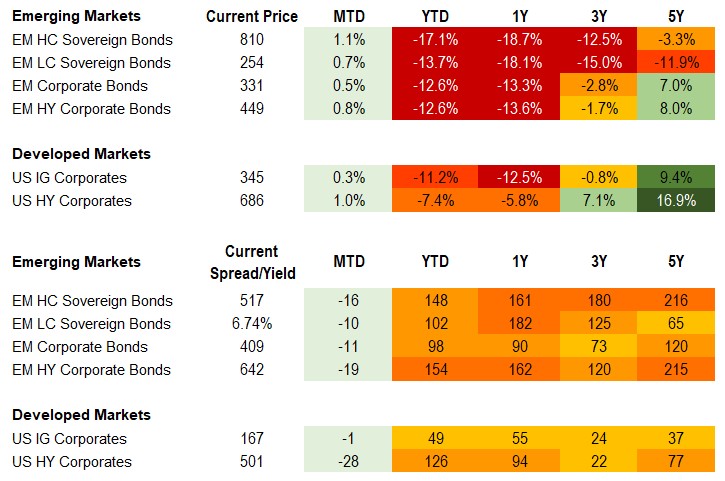
Equities
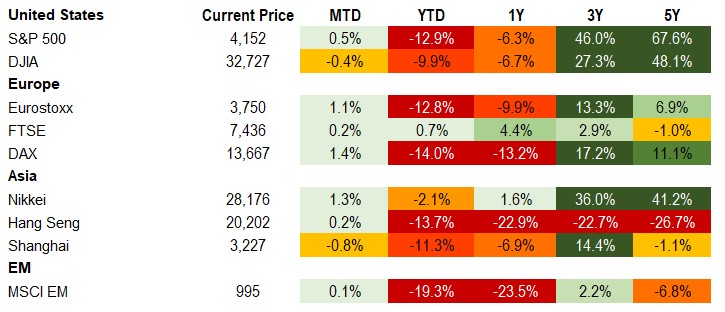
Commodities

Source for data tables: Bloomberg, JPMorgan, Gramercy. EM Fixed Income is represented by the following JPMorgan Indicies: EMBI Global, GBI-EM Global Diversified, CEMBI Broad Diversified and CEMBI Broad High Yield. DM Fixed Income is represented by the JPMorgan JULI Total Return Index and Domestic High Yield Index. Fixed Income, Equity and Commodity data is as of August 5, 2022 (mid-afternoon).
Emerging Markets Weekly Highlights
U.S. visit to Taiwan prompts largely expected Beijing response
Event: This week, U.S. House Speaker Nancy Pelosi visited Taiwan, marking the highest-level U.S. visit in 25 years. The visit prompted Beijing to announce People’s Military Army (PLA) exercises from August 4th to the 7th surrounding Taiwan and crossing Taiwan’s Air Defense Identification Zone (ADIZ) and the median line.
Gramercy commentary: We view the move as incrementally escalatory but largely in line with anticipated responses to the U.S.’s provocation. While the exercises are moderately more aggressive than those during the 1995-96 Taiwan Strait Crisis, with the firing of missiles over Taiwan for the first time, the duration appears to be shorter and incentives, at least in the near-term, remain to prevent significant further escalation. Brief supply chain disruptions are possible as a result of the exercises. On the constructive side, Beijing characterized the response as a deterrent to Taiwanese independence and still referred to peaceful unification. With that being said, while not our base case, odds of a more protracted security crisis have increased with room for further bouts of tension, particularly as the Party Congress nears in the fall.
Argentina announces new measures in aim to stabilize the macroeconomic backdrop
Event: Newly appointed ‘super’ Minister Sergio Massa gave a speech detailing actions to restore sentiment, improve the macroeconomic backdrop, and meet current IMF fiscal and net FX reserve targets. Fiscal measures announced included subsidy reduction for the highest income segments of the population as well as consumption limits on the remainder of the population, wage freezes, amendments to social programs, and a voluntary local debt exchange to better manage maturities. External efforts entail incentives to boost FX reserves from exporters including sales at a more attractive exchange rate, controls to reduce under-invoicing of exports, and ongoing discussions regarding repo facilities with banks or a sovereign wealth fund.
Gramercy commentary: We see the plan as constructive with the right intentions. Under our base case, Massa is able to successfully execute on the consolidation needed in 2H22 to avoid arrears with the IMF largely through real capital expenditure, wage and pension adjustments, and/or a combination of further amendments from the Fund. Incentives for exporters should marginally improve the net FX reserve picture along with some seasonality on energy imports while the government continues to work on additional efforts in this area. The gap between the parallel and official rate has stabilized for now at around 125%, down from its peak of 165%. Going forward, evolution of net FX reserves and fiscal data will be monitored closely in the context of the next IMF program review and the chunk of local maturities beginning in September.
Brazil’s Central Bank signals hiking cycle may be nearing its end; Bolsonaro makes campaign pledges while polls narrow
Event: COPOM raised the Selic rate as expected by 50bps to 13.75% with a relatively dovish tone indicating only residual adjustments may be necessary. Meanwhile, President Bolsonaro revived a proposal to lower income tax brackets for 2023 and promises to increase mandatory spending in a potential second term. A new PoderData poll points to a slight narrowing of the presidential race with former President Luiz Inacio Lula da Silva ahead with 43% of votes followed by President Bolsonaro with 35% and it shows Lula ahead by 10 percentage points in a run-off down from 13% in the last poll.
Gramercy commentary: We see the guidance by COPOM indicative of an additional 25bps hike in September with room for a potential pause in the hiking cycle. Thereafter, depending on the momentum of inflation and growth dynamics, moderate additional hikes may be needed but with growing chances of an end of the hiking cycle as the election nears. We think any additional fiscal measures this year will be difficult to achieve, but Bolsonaro’s latest promises could complicate fiscal policy in the next administration.
Emerging Markets Technicals
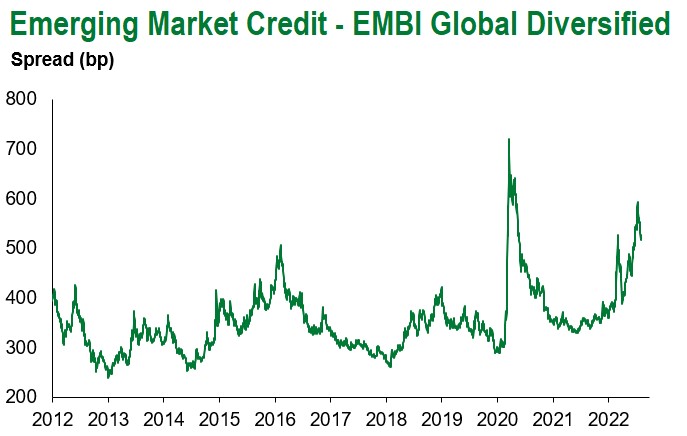
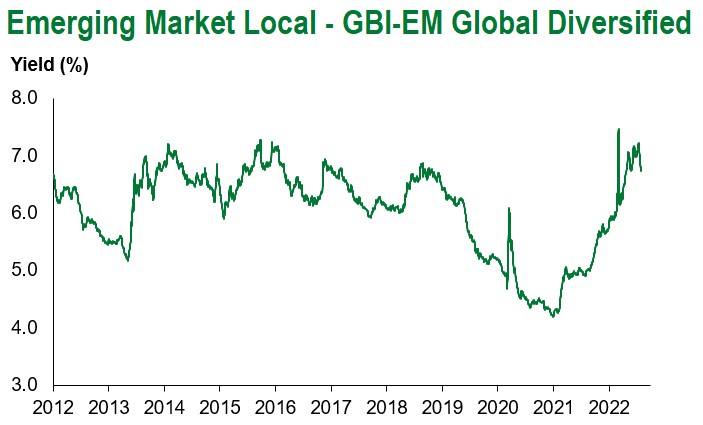
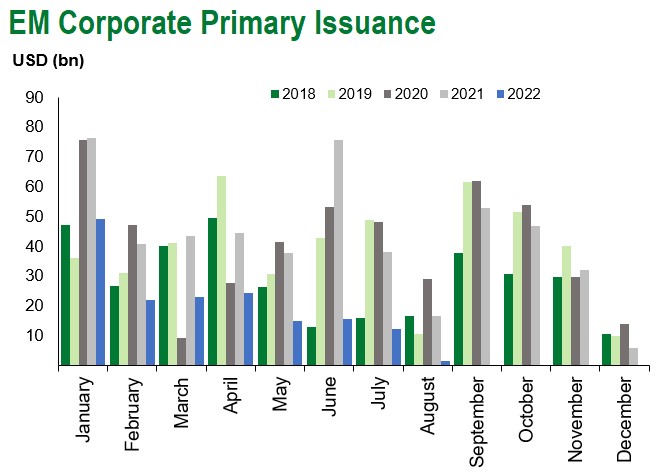
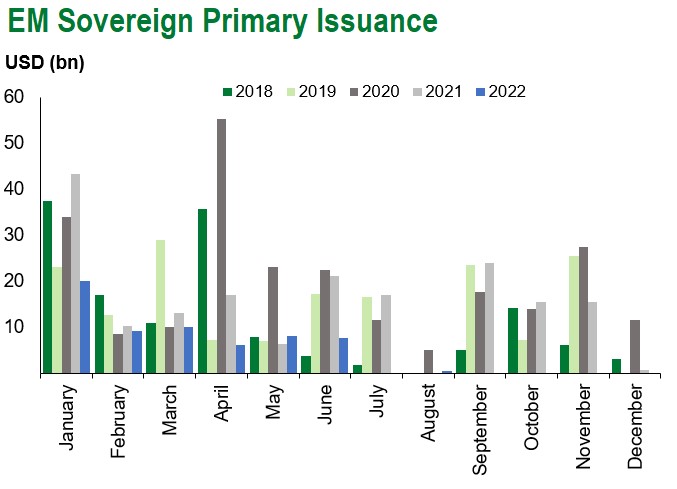
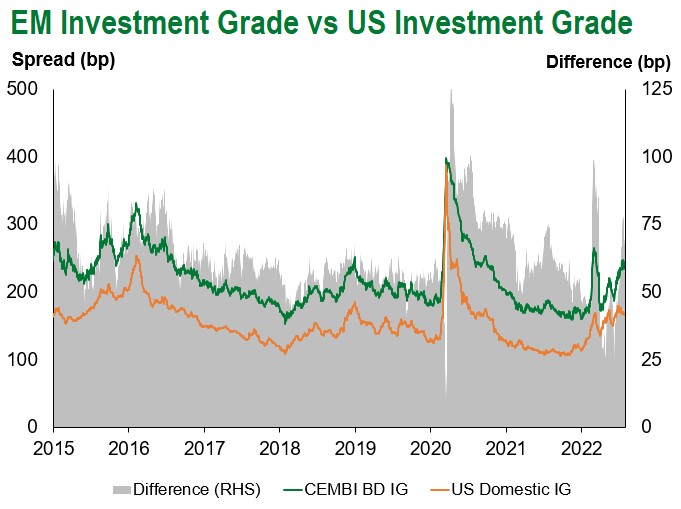
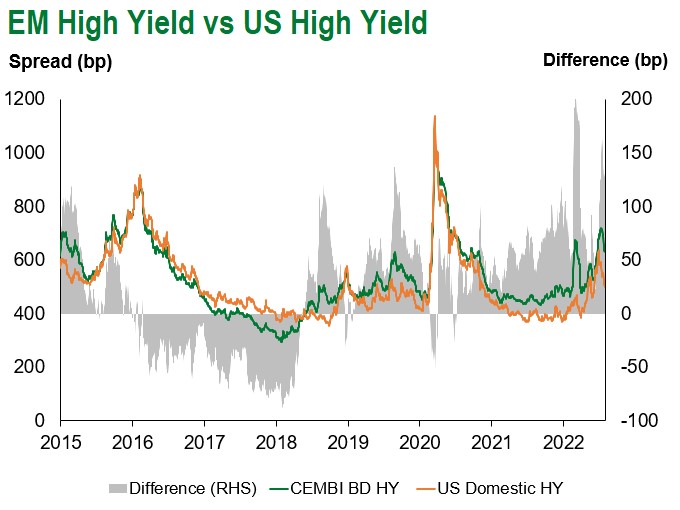
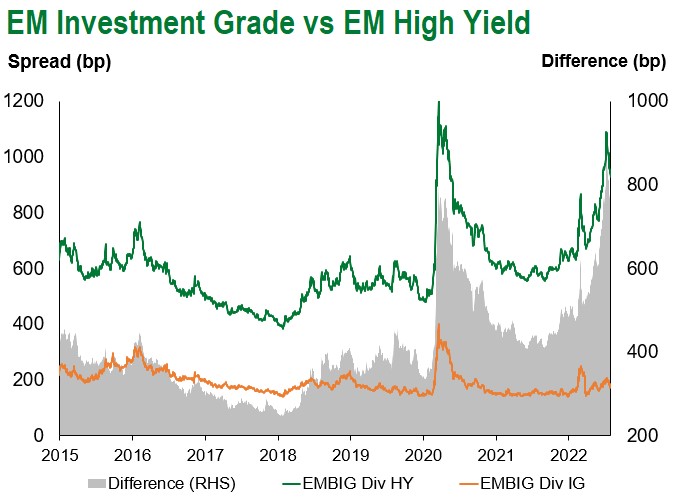
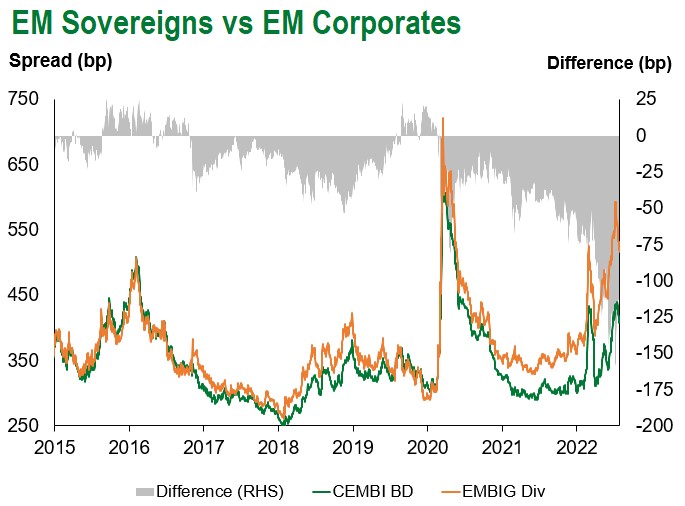
Emerging Markets Flows
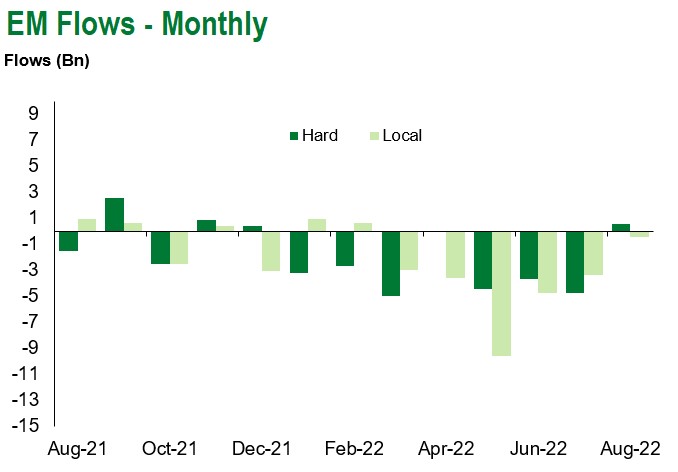
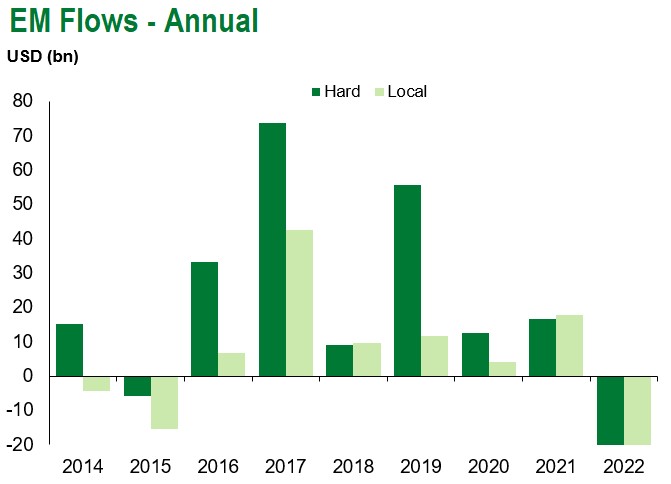
Source for graphs: Bloomberg, JPMorgan, Gramercy. As of August 5, 2022.
COVID Resources:
Johns Hopkins COVID-19 Case Tracker
For questions, please contact:
Kathryn Exum, CFA ESG, Director, Co-Head of Sovereign Research, [email protected]
Petar Atanasov, Director, Co-Head of Sovereign Research, [email protected]
James Barry, Director, Deputy Portfolio Manager, [email protected]
This document is for informational purposes only. The information presented is not intended to be relied upon as a forecast, research or investment advice, and is not a recommendation, offer or solicitation to buy or sell any securities or to adopt any investment strategy. Gramercy may have current investment positions in the securities or sovereigns mentioned above. The information and opinions contained in this paper are as of the date of initial publication, derived from proprietary and nonproprietary sources deemed by Gramercy to be reliable, are not necessarily all-inclusive and are not guaranteed as to accuracy. This paper may contain “forward-looking” information that is not purely historical in nature. Such information may include, among other things, projections and forecasts. There is no guarantee that any forecasts made will come to pass. Reliance upon information in this paper is at the sole discretion of the reader. You should not rely on this presentation as the basis upon which to make an investment decision. Investment involves risk. There can be no assurance that investment objectives will be achieved. Investors must be prepared to bear the risk of a total loss of their investment. These risks are often heightened for investments in emerging/developing markets or smaller capital markets. International investing involves risks, including risks related to foreign currency, limited liquidity, less government regulation, and the possibility of substantial volatility due to adverse political, economic or other developments. The information provided herein is neither tax nor legal advice. Investors should speak to their tax professional for specific information regarding their tax situation.
